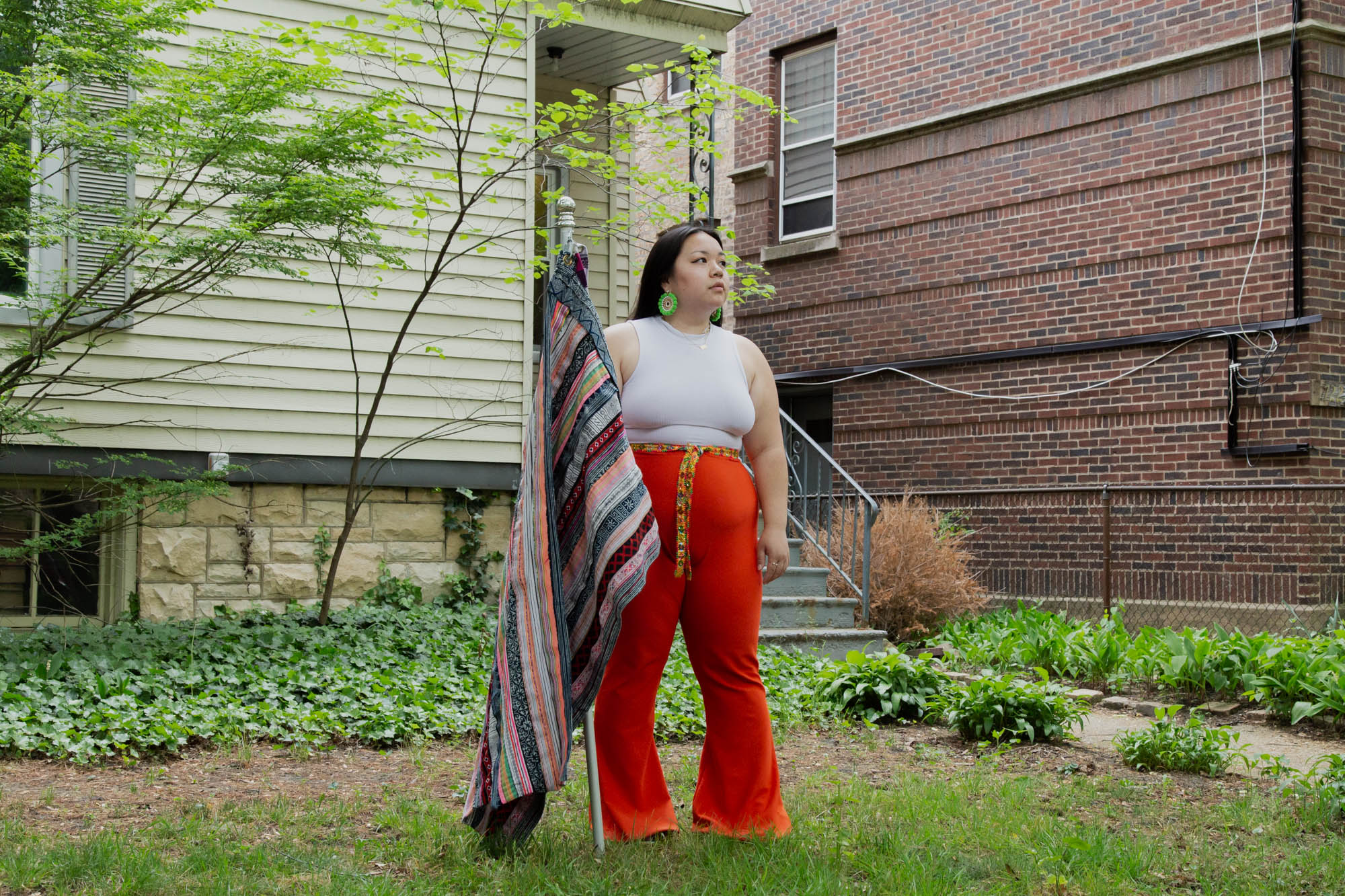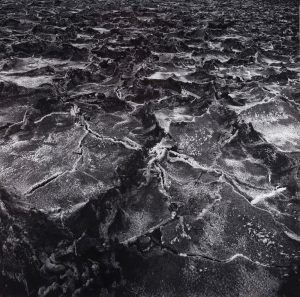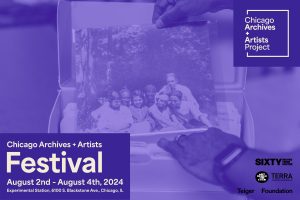I recently interviewed Chicago artist and second generation HMong-American Tshab Her, where we discussed her latest artwork, what it was like to grow up as a second-generation HMong-American, the process she took to create her newest installation, and what it means to create space through art and storytelling as a HMong-American artist.
To understand the HMong diaspora in America, we have to start when it all began during the Vietnam Conflict. Fearing Communist takeover, the United States government, under the leadership of the CIA, recruited the ethnic minority group HMong in Laos in the early 1960s-70s to fight in the Conflict in what we now know as the “secret war.” According to the Migration Policy website, in May of 1975, the United States began evacuating 1,000-3,000 HMong into Thailand and by December, 1975, when the Lao People’s Democratic Republic was formed, over 44,000 HMong fled into Thailand as refugees. As of 1999, official refugee camps were closed because the Thai government had never officially allowed HMong resettlement within its borders. Due to their involvement in the US-led war, 90% of the HMong population have been resettled into the United States beginning in December 1975, where about 3,500 of the ethnic minority population were of the first to be granted asylum in the United States under the Indochina Migration and Refugee Assistance Act of 1975. The first wave of HMong refugees were predominantly men who fought directly under General Vang Pao’s secret army. The second wave of HMong refugees didn’t occur until the Refugee Act of the 1980s, which allowed families to enter the United States, building new communities throughout the Midwest in Minnesota, Wisconsin, Illinois, and other regions of the country. California is home to the largest HMong population. Today, there are approximately 300,000 HMong people living in the United States according to the 2010 U.S. Census Bureau. *
Reader’s note from the artist: “HMong is commonly spelled “Hmong” in English. There are two dialects used in the United States: Hmoob Dawn and Moob Leeg. My family speaks Moob Leeg. I will be capitalizing both the H and the M in HMong to be inclusive in both dialects.”
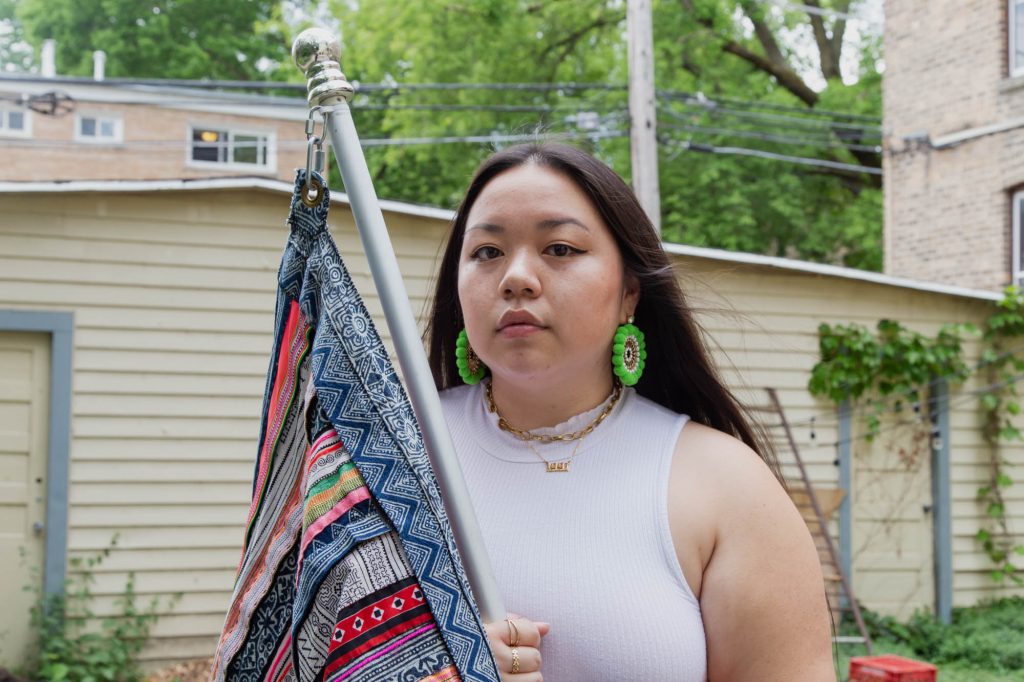
Danielle Krull: Please tell us a little about yourself.
Tshab Her: I am a second generation HMong-American woman. I graduated from the University of Illinois at Chicago in 2016 with a Bachelors of Fine Arts in Studio Arts and currently work part-time at the Chicago Public Library as a Children’s Library Associate. I live in an intentional Christian community called The Patch; the term “Christian” is loosely held in my vocabulary. The Patch is led by my friend and mentor James Kant and thrives in the spirit of love and kinship. This is a space where I am able to unlearn/relearn, deconstruct, decolonize, heal, and live as my true self. I am grateful to have a safe space to process and to be surrounded by people who share the importance of community together in meals, conversations, and fellowship.
DK: Please tell us about the art you create.
TH: Through the use of embroidery, installation, language, clothing, social media, and performance, my work engages the tension of belonging by confronting and rejecting my internationalization of the white gaze, religious trauma, body dysmorphia, sexuality, family bondage, and patriarchal structures.
The work I create informs my identity as a second generation HMong-American woman searching for my authentic self. In the struggle to break free from the erasure and displacement, I use my voice with urgency by reclaiming space through storytelling and kinship. My work/body is a self-love practice, blending colors and words into my everyday life as an act of radical resistance.
DK: Can you share with us your family’s immigrant story?
TH: My father immigrated to the States in the late 70s and my mother in the early 80s. They met here in the States and got married shortly after. The story of my parents is a hard, heartbreaking story of loss, displacement, bloodshed, fear, and hunger. It wasn’t until a few years ago that my parents told me their separate stories of fleeing their home in Laos to the urban landscape of America. These stories are precious gifts I am not ready to share yet, but will hold and honor their stories with humility, love, and respect.
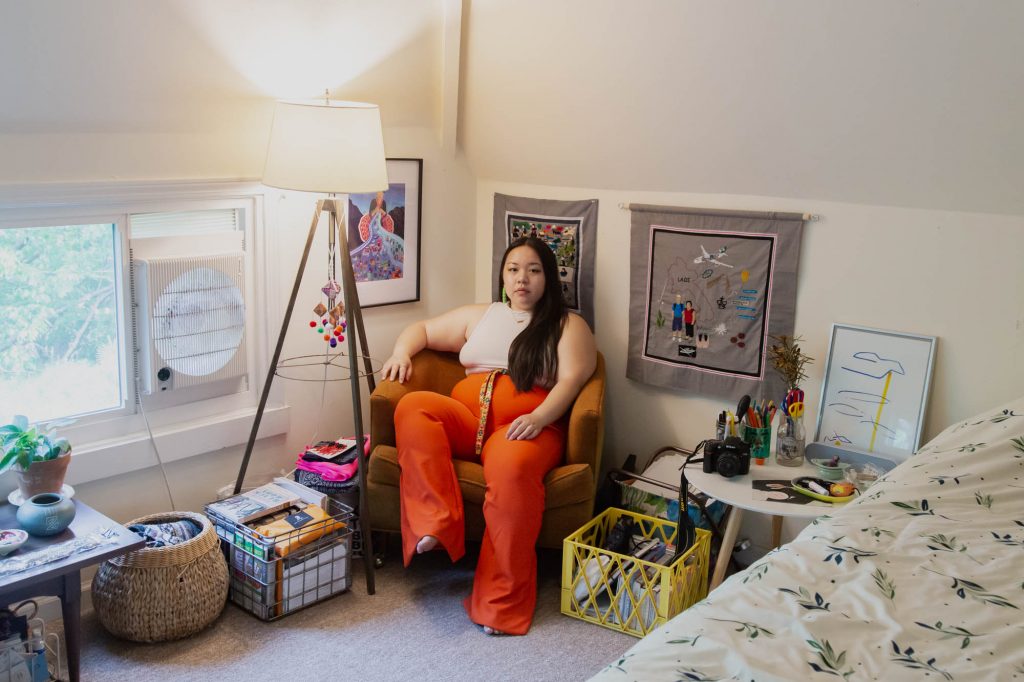
DK: What was it like being raised as a second generation HMong in the United States/Chicago?
TH: I grew up in the suburbs, 40 minutes west of Chicago, in West Chicago and North Aurora. My father worked outside the home and my mother stayed at home with us until my younger sister started high school. The only HMong folks I knew growing up in the area were at church, which I attended weekly and became influenced by the culture of the HMong church until college.
I viewed my second generation HMong-American experience through the lens of the HMong church, which today, I am deconstructing what that means and reanalyzing my position and autonomy as a 29-year-old HMong woman.
I always felt like I was living a double life growing up as a second generation HMong-American in the United States. The duality of my identity could not have been more explicit through my given names–I was Jennifer and I was Tshab. These two identities collided with one another and caused tension in my body. I have always and only identified with Tshab, yet legally I was named Jennifer. I was Jennifer at school, at doctor’s appointments, and at work. I was Tshab at home, with close friends, and at church. My parents decided, or were told, that having an English name would help us navigate the States. Though unfortunately true, I could not relate to this Anglicized name.
DK: What does it mean to be HMong in the United States for you?
TH: To be HMong in the United States is to actively make space. To be HMong in the United States is to retell the same stories and histories just to place yourself in someone else’s ignorance. To be HMong in the United States is to be a displaced peoples—longing for a non-existent homeland, a faraway, imagined land—a colonized, forcibly taken-away land. To be HMong in the United States is to acknowledge my indigenous roots and to honor my ancestors. To be HMong is to recognize that I am here even if others choose not to recognize my existence. To be HMong is to be human. To be HMong is to just be.
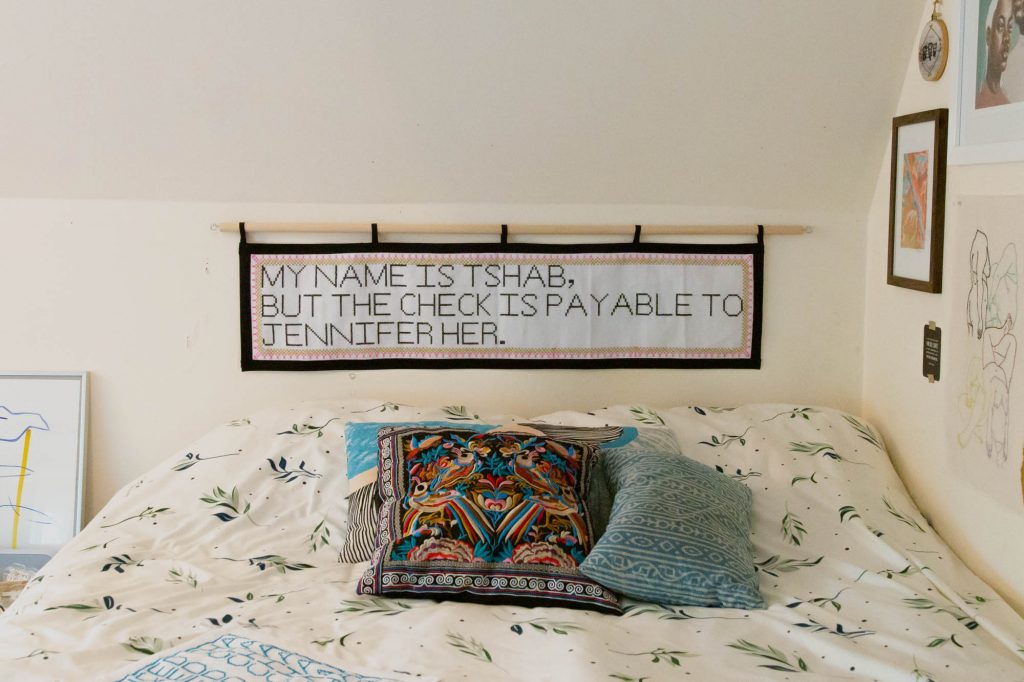
DK: What was the process/journey for you to take the initial steps of creating this multi-colored flag piece?
TH: I had created a few flags during undergrad at UIC and was interested in the meanings of flags, especially as a people who does not have a country to call home. An example of this is when I created a flag out of a traditional HMong skirt. Since we do not have an official flag as HMong people, I wanted to quickly fix this by hanging a HMong skirt on a pole. This simple gesture felt really significant because these skirts are worn by HMong women and girls, who are the foundation of the HMong community.
I have always believed that the bright colors of “traditional” HMong clothing beautifully represent the resilience and power of my people. Even though we have been persecuted, hunted, displaced, and on the run for centuries, the bright colors on our backs marked our existence and survival. The bright pinks, reds, blues, and yellows are contrasted against the dark greens, browns, and grays of the East and Southeast Asian landscape.
Another project that inspired We Are: Chang, Chang, Chue, Fang, Hang, Her, Khang, Kong/ Suong, Kue, Lee, Lor, Moua, Pha, Thao, Vang, Vue, Xiong, Yang, my latest work, is an installation I created during undergrad called Reclaiming Existence. I painted horizontal lines on the lobby walls of the art building [on campus] with a common HMong pattern referencing a textile sewn by my grandma. Over the course of the spring semester, I slowly sanded down the walls until the pattern disappeared. I wanted to showcase the removal of this pattern in parallel to the removal of HMong bodies, highlighting the impermanence of place/space from forced migration and persecution.
For my flag project, instead of removing and erasing, I decided to utilize the action of adding and taking up space after conversing with the Justice Hotel curators for the Windows to the World exhibition at 6018|North. I decided that I wanted a future where HMong folks lived freely without questions about who we are, where we are from, and why we are here.
This project was originally planned to utilize the fences at 6018|North, weaving bright colors around the house to reference HMong textiles. But in conversation with my friend James, he suggested creating a flag instead since fences act as borders, like in my previous work. A flag better represents HMongness.
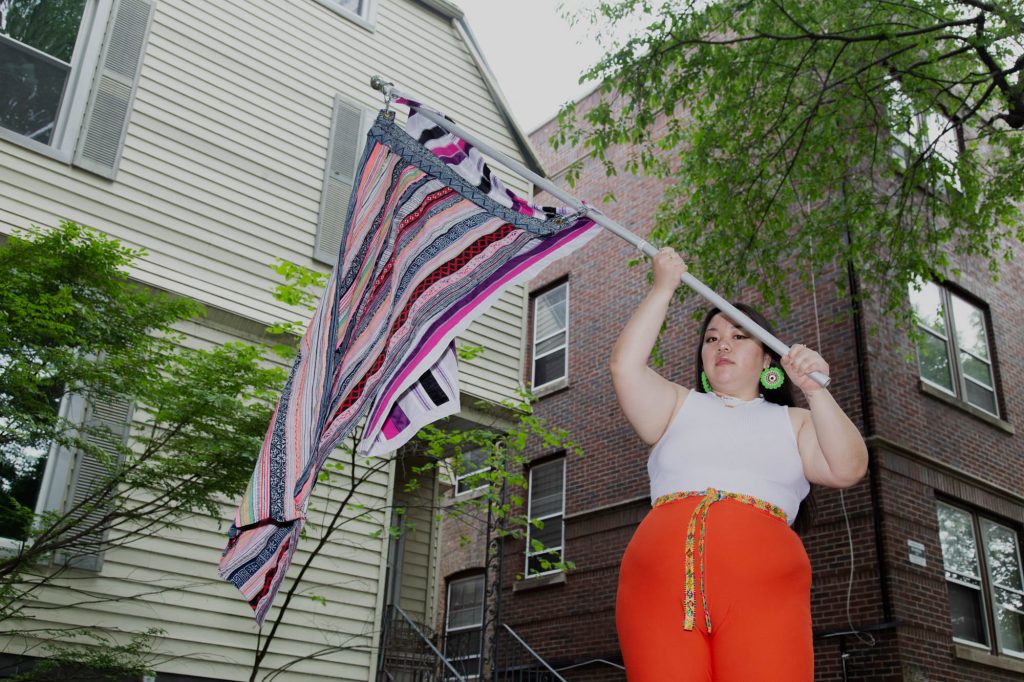
DK: What does the flag represent?
TH: We Are: Chang, Chang, Chue, Fang, Hang, Her, Khang, Kong/Soung, Kue, Lee, Lor, Moua, Pha, Thao, Vang, Vue, Xiong, Yang is a performance piece with a flag and sound that commemorates the 18 clans of the HMong diaspora. Each stripe on the flag represents a clan. I belong to the Her clan. I created the flag to make space and make known the stories of my people. The flag started off with only three stripes displayed at 6018|North, and over the course of four weeks, grew into a completed flag of 18 stripes.
Seeing the flag come alive after four weeks was grounding. I could feel my ancestors’ spirit on the land; we have come a long way. I celebrated their presence by engaging with their descendants through an audio recording of 18 HMong women reciting their clan name at 6018|North, August 2020.
DK: Why did you decide to create this piece now?
TH: I am always looking for ways to create a space for my people, whether it is through art, poetry, fashion, or by simply existing as my true self. The final iteration of this project stemmed out of many conversations; I did not do this on my own accord. I may have been the one to construct the flag and perform, but it is my friends, my community, the curators of the Justice Hotel, 6018|North, my mother, family, and the stories of my people who should be recognized and honored. They helped carry and support my desires and longings as a HMong woman learning how to exist authentically. Although my name is attached to this project, it is a project made by all people. We are connected by the spirit of gratitude and remembrance.
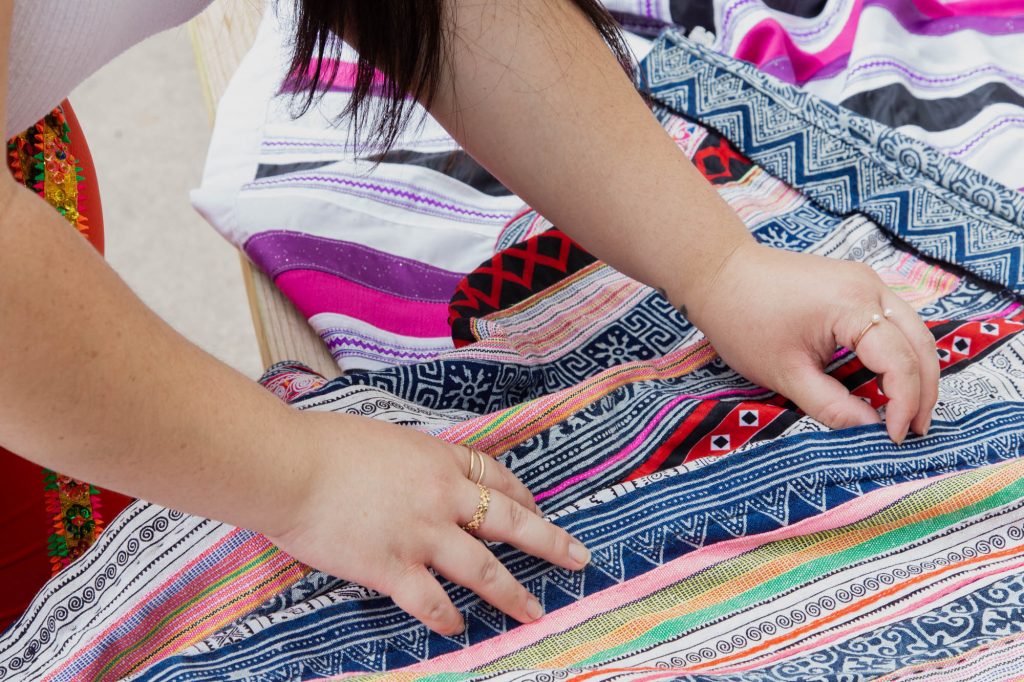
DK: The textiles you integrated into your flag–what makes the textiles specifically HMong? Have we seen these textiles used elsewhere?
TH: The textiles I used for the flag were either from my mother’s collection or from a small HMong woman-owned business in Thailand. Some of the fabrics were made with batik, a traditional craft technique still being used today. The textiles showcase patterns and symbols known to the HMong, such as the elephant, foot, house, snail, or mountains.
As for being used elsewhere, HMong textiles have most definitely been culturally appropriated. Some examples are machine-printed HMong patterned scarves at Walmart named “Aztec.”
Another example is the white designers in Europe, such as Eponine London, who visit HMong villages in Southeast Asia and buy from the markets and profit off their “unique” designs. In 2018, Prince Harry’s ex-partner, Cressida Bronas, wore an Eponine London’s dress to the royal wedding. There was an uproar in the HMong community calling out the cultural appropriation and misuse of textiles, but there were also some folks celebrating. Why were they celebrating? Whiteness ruled and to be seen by white counterparts made them feel legitimate, even though the misuse of our textiles is violent–it takes away the spirit of our ancestors. Despite being constantly displaced, my ancestors continued to create beautiful textiles and clothing. This craft survived centuries of movement and marks their resilience and ownership of self.
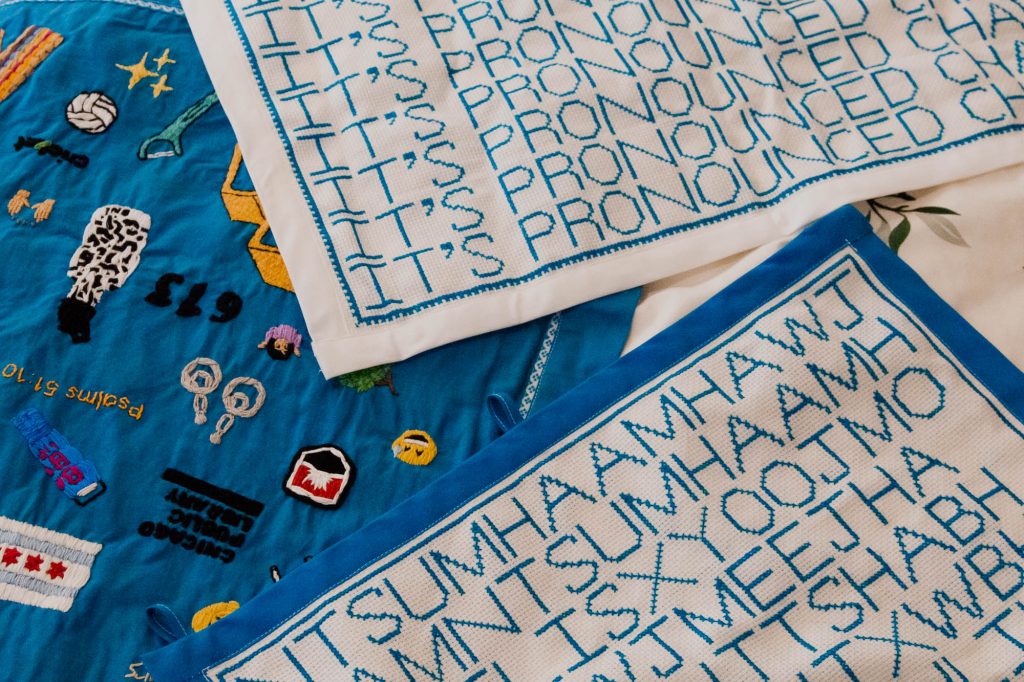
DK: How long did the process take for you to hand sew the fabrics?
TH: I constructed the flag over the course of three months and I split the 18 stripes into five sections for the performance. Previously, my mother helped design, construct, and sew my textile projects. I took her lead and learned many techniques. Sometimes she would even take the project away from me because I was either working too slow or not efficient enough. I value and hold these moments close because we were able to bond and spend intentional time together as mother and daughter.
I am grateful that I was able to connect with my mother in this way. I mention this because this flag project was the first time I created a project without the assistance of my mother and it felt very emotional. I was now on my own, having to trust the skills and techniques taught by mom. I believe I did an amazing job and I am grateful for the teachings of my mother and those that came before her.
DK: Tell us about the performance piece that was shown. Do you plan to reinstate the performance once more places open in this new transition of the pandemic?
TH: There were four performances over the course of four weeks. During each performance, I attached more stripes on the flag to build a completed flag of 18 stripes over time. A week before the first performance, I mounted a flag pole on the 6018|North house with the assistance of their maintenance crew. I placed the first few stripes on the flagpole and had it flying in the sky for the first week before the first performance.
During the performances, I emerged out of the second floor windows on the roof of the 6018|North house and removed the flag pole from the mount. I would then carry the flag back into the house, down to the first floor, and outside to the front yard where a table was placed with the stripes of the flag that were to be attached. I attached the stripes onto the existing flag and walked down the yard to present the new addition. I then walked back up the stairs into the house to the second floor and back to the roof to remount the flag. The performance ended once I went back into the second floor window. To advocate and create space for HMong women in a patriarchal society, I found 18 HMong women from each clan to recite their clan name during the five minute performance piece. Hearing these HMong women say their names gave me a visceral response of belonging.
I haven’t considered reinstating the performance at the moment, but I have considered mounting the flag outside my home or other places as a traveling flag–passing and marking spaces.
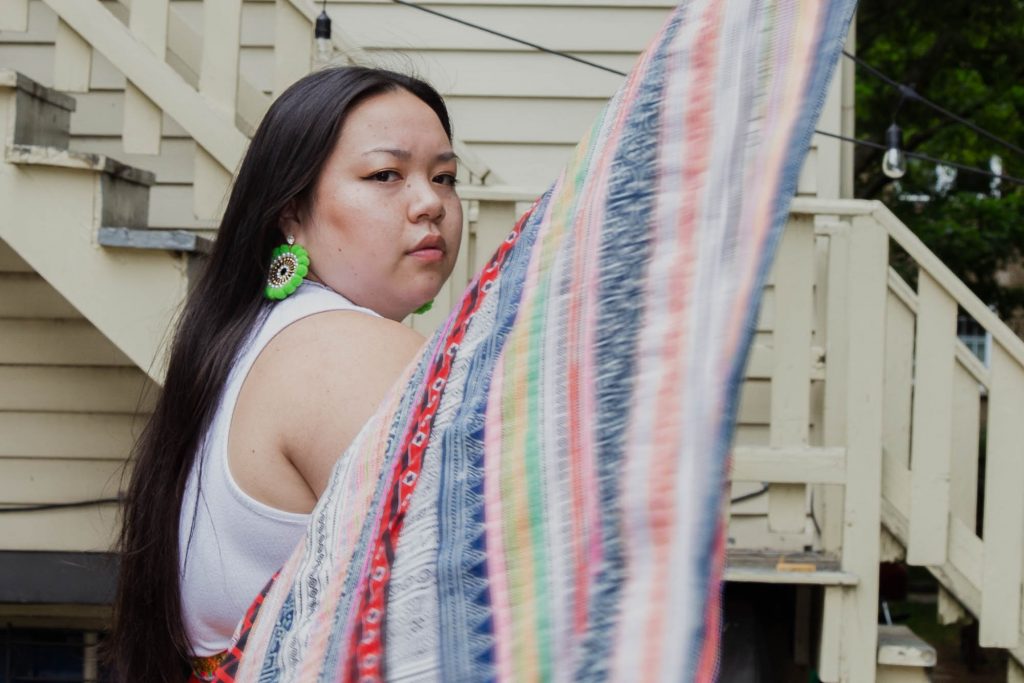
DK: What do you want the readers to take away from your latest artwork as an artist?
TH: I want readers to recognize, place, and honor the HMong story. We have always existed and I want readers to know that we are who we are because of the resilience of our ancestors. I want readers to be able to advocate for not only my people’s stories, but also for other marginalized communities. We are the voice and we are powerful together. I want the HMong readers to know that we do not need to be seen by whiteness. We are who we are because we simply exist as us. We are able to mold to the changing landscape and be creative in succeeding wherever we are. I want HMong readers to lament and process the dualities of being HMong and American.
DK: Are you working on any new projects that you’d like to share?
TH: I am currently working on a few embroidery projects, but have been mostly focused on writing poetry and existing in my body with colorful clothes. I am also making earrings out of Hmong textiles and beads for my new small business It’s Pronounced Cha. I am now selling my jewelry and prints at Buddy in the Garland Gallery of the Chicago Cultural Center. People can also check out www.tshabher.com to learn more on upcoming projects.
Featured image: Tshab Her holds her flag piece that was part of her performance We Are: Chang, Cheng, Chue, Fang, Hang, Her, Khang, Kong/Soung, Kue, Lee, Lor, Moua, Pha, Thao, Vang, Vue, Xiong, Yang while looking to the viewer’s right. She wears a white shirt, gold necklaces, orange pants, and hand-made green earrings. Photo by Josh Johnson.
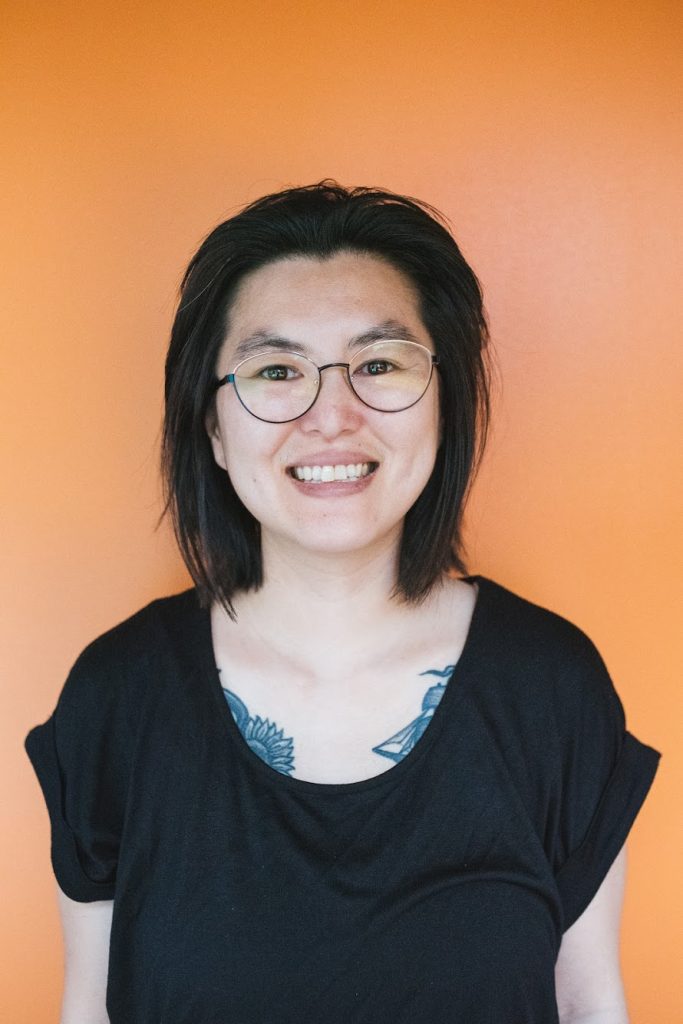
Danielle Krull is a Seattle based writer who loves telling stories of food, immigrant and refugee communities, and the Midwest. Her works have been published in Barista Magazine, Inheritance Magazine, and Womanly. In her free time, she is working on a personal project that centers around adoptees and finding their identity through their first culture food ways. You can follow along on her IG @itsmedleighkrll.
